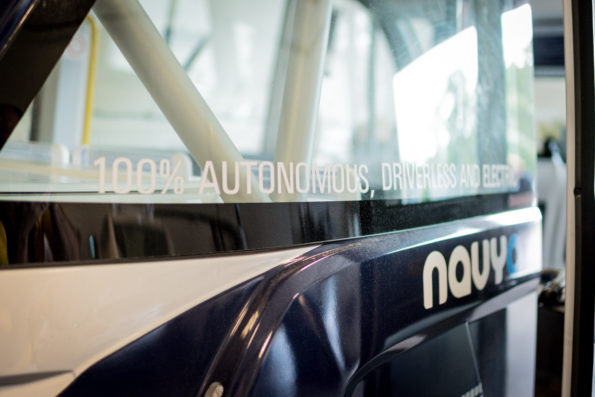A driverless shuttle ferries passengers to work from a far-away parking lot. A connected vehicle senses a car stopped ahead around a blind curve and gently brakes, avoiding an accident.
 These scenarios give a glimpse of the future of connected and automated transportation, and they’re happening right now on the University of Michigan’s campus.
These scenarios give a glimpse of the future of connected and automated transportation, and they’re happening right now on the University of Michigan’s campus.
Leading the way is Mcity, a unique public-private partnership that brings together researchers and collaborators from industry, government and academia, all working to make advanced mobility vehicles and technologies a reality for the benefit of society.
In June, Mcity launched the Mcity Driverless Shuttle, the first such project in the U.S. focused primarily on user-behavior research and data collection. The project uses two fully automated, 11-passenger, all-electric shuttles to cover a roughly one-mile round-trip.
The shuttle project is a study of driverless technology, but experts say automation is just part of the solution. Connectivity—vehicles’ ability to talk to each other and to the infrastructure—is key to a safer transportation future.
“We believe connectivity and automation together offer the greatest potential to make vehicles safer, as well as reduce fuel use and increase access to transportation to those with few or no options today,” said Carrie Morton, deputy director of Mcity.
While what is being learned through Mcity’s work potentially has national, even international, implications, and the research is mostly confined to U-M’s campus and Ann Arbor, it touches cities and towns across Michigan.
Whether in car or on foot, in St. Joseph, Saginaw, Sault Ste. Marie or anywhere in between, residents of Michigan and beyond will one day see the impact of Mcity’s work to advance the development of cars that drive themselves and communicate with each other, making roads safer for all.
“From the streets of Ann Arbor to the roads of the Mcity Test Facility, U-M is leading a transition to connected and automated vehicles that will transform how people and goods move around the world,” said Mcity Director Huei Peng, who is also a professor of mechanical engineering and the faculty lead on the shuttle research project.  The Mcity Driverless Shuttle is one example.
The Mcity Driverless Shuttle is one example.
It carries students, faculty and staff to the North Campus Research Complex from more distant parking, and provides easy access to the U-M/Ann Arbor Area Transportation Authority bus stop at Hubbard and Hayward streets. Future plans include route expansion and accessibility research.
While the shuttles are driverless, a conductor is on board at all times, with the ability to immediately stop, if necessary, for safety reasons. Mcity’s team of safety conductors completed comprehensive training on the shuttle, both inside the Mcity Test Facility and on the route at NCRC. About 1,000 test runs were conducted inside the test facility. In total, approximately 500 hours of testing and training were completed, including 200 hours of training by the conductors.
 The shuttles rely on lidar, which uses invisible laser beams, to build a view of the surrounding environment, and GPS for localization.
The shuttles rely on lidar, which uses invisible laser beams, to build a view of the surrounding environment, and GPS for localization.
Through the project, Mcity is studying how passengers react to the driverless shuttles as a way to gauge consumer acceptance of the technology. The shuttles are equipped with onboard cameras and Wi-Fi communications to capture data generated during operation.
Interior cameras record the reactions of riders inside the shuttle. This includes the use of video and audio recordings, and photos from the videos. Exterior cameras capture the reaction and behavior of other road users, including other vehicles, bicyclists and pedestrians.
Mcity will use Wi-Fi data, already gathered by the university, to learn about ridership and usage patterns, and is working with J.D. Power to survey users about their experience. Mcity’s data protection plan will safeguard riders’ privacy.
“The research obtained from our surveys will help the industry understand the rider’s experience on the driverless shuttle as well as non-riders who interact with the shuttle as it operates on U-M’s campus,” said Kristin Kolodge, executive director of driver interaction and human machine interface at J.D. Power. “Examining the experience from both perspectives will help industry stakeholders better understand consumer acceptance of driverless technology.”
Peng said Mcity is excited to begin the important work.
“The data we collect will help researchers understand user trust over time, as well as how to design safer vehicles and how to operate them more efficiently,” he said. “Safety is Mcity’s highest priority.”


